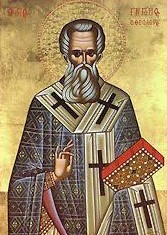St. Gregory of Nazianzus | January 1

Gregory of Nazianzus, one of the three Cappadocian Fathers (along with St. Basil and Gregory of Nyssa) is honored as one of the great doctors of the Church. St. Gregory (329-389) was born near Arianzus in Cappadocia. Gregory was born into a wealthy family near Nazianzus in southwest Cappadocia. His Father was the bishop of Nazianzus and his mother was Nonna. Like Basil, he received the best education, in Caesarea of Cappadocia and Caesarea of Palestine. He studied further in Alexandria.
On the way to Athens the ship was nearly lost, in a violent sea storm putting in peril not only his life but also his salvation. With tears and fervor, he besought God to spare him, vowing to dedicate his whole self to Him, and the tempest gave way to calm and the thought of sudden death moved him to dedicate the rest of his life to God. He spent the next eight years at Athens, studying rhetoric under pagan teachers.
It was in Athens that the acquaintance already begun, between him and Basil at Caesarea, forged into a strong, deep friendship and lifelong brotherly love. The two spent some time together exploring the monastic life in Pontus, another province of Asia Minor (today’s Turkey). He finally returned to Cappadocia, and was baptized by his father. After a brief but fruitful try at the monastic life with Basil, he yielded to his father’s request by returning to Nazianzus and being ordained. He spent the next ten years assisting his father in both church and business affairs.
Gregory was a prolific writer and frequent speaker. His writings, both prose and poems, his lofty eloquence and his wondrous breadth of learning, is considered to have surpassed the Greek writers of antiquity, and because of his God-inspired theological thought, he received the surname “Theologian.” He was thus called “St Gregory the Theologian” because of his great learning and talent for oratory. He is especially called “Trinitarian Theologian,” since in virtually every homily he refers to the Trinity and the one essence and nature of the Godhead.
His five theological orations, delivered at the council in 381, are perhaps the best known. In them he expounded and further developed the Nicene Creed, arguing for the distinctiveness of the three persons of the Trinity, for the full humanity of Christ, and for the full deity of both the Son and the Holy Spirit. He also wrote much poetry, of which we have copies of over 16,000 lines. Gregory has had a vast influence, not only through his writings, but also through those men who were his pupils, such as Jerome. In 381 he became Archbishop of Constantinople. It was during this period the Arian heresy was at its height.
St. Gregory of Nazianzus, the close friend and contemporary of St. Basil the Great, is also known as St. Gregory the Theologian. The second of the three Cappadocian Fathers, St. Gregory’s life is also very closely tied with a vehement defense of the First Ecumenical Council, held in Nicea in 325, and its definition of the Son as being of the same substance as the Father. Like St. Basil, Gregory was too young to have dealt with Arius and was an influential 4th century Christian theologian and monastic. He received lots of slander, insults and even personal violence. He was a great Father and Teacher of the Church. He is commemorated on Jan 1.